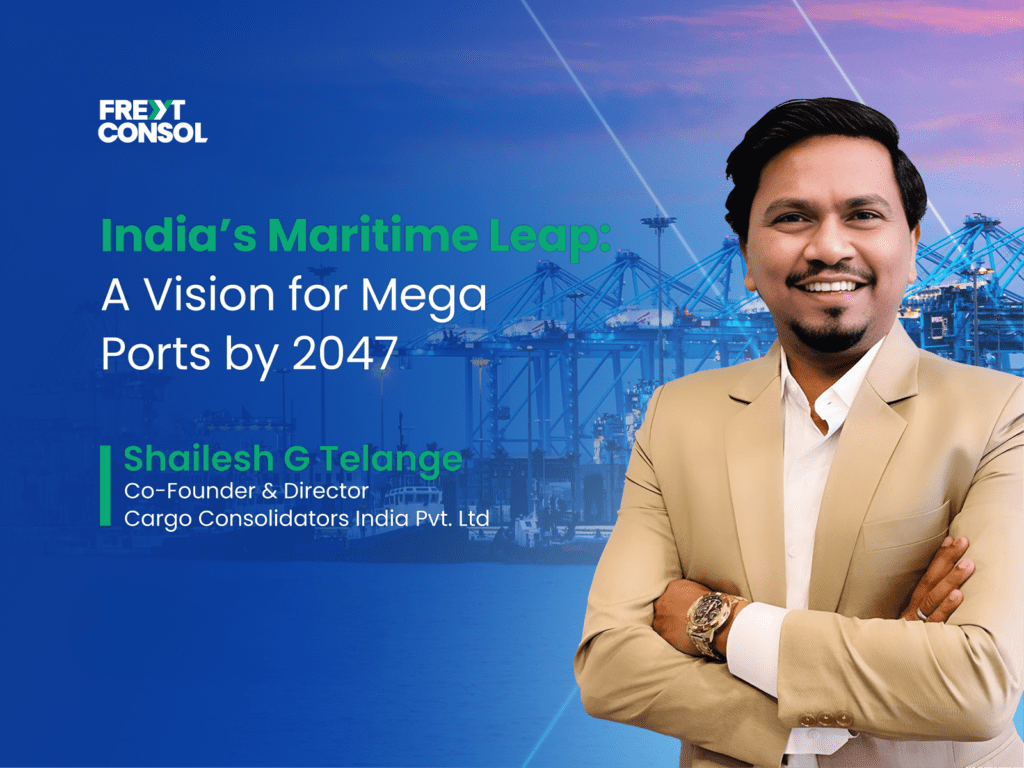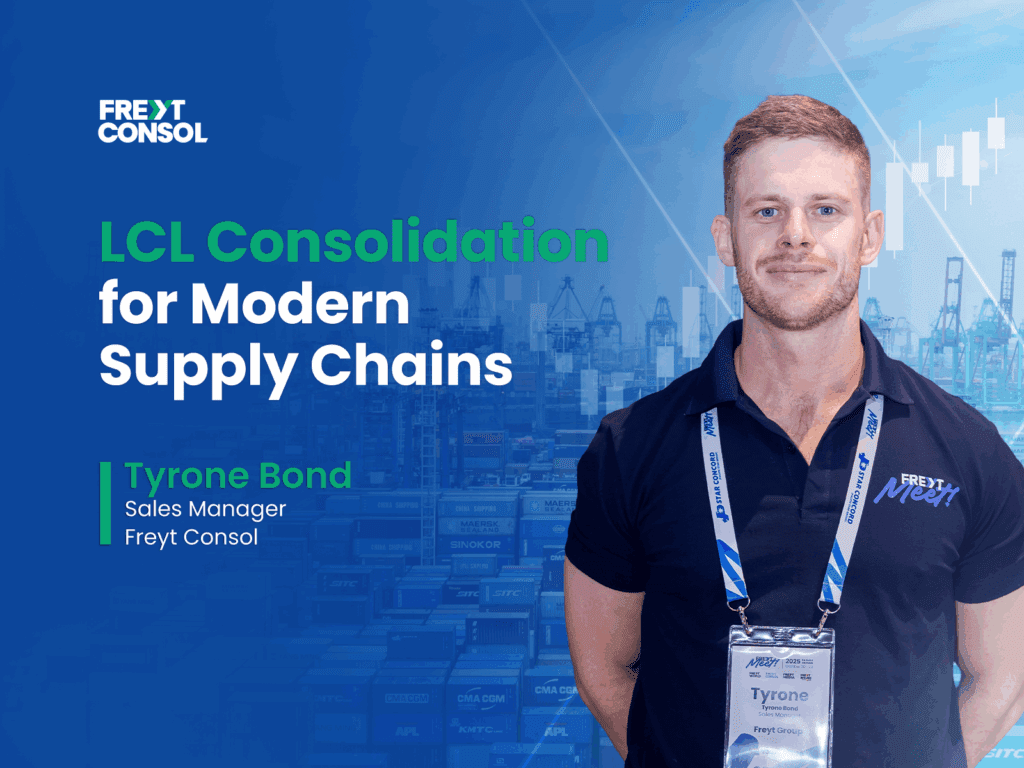By Shailesh Telange, Co-Founder & Director of Cargo Consolidators India Pvt. Ltd

India’s maritime sector stands on the cusp of a transformation that could redefine its role in global trade.
The Maritime Amrit Kaal Vision 2047, detailed in a Swarajya report on April 2, 2025, aims to develop six mega port clusters, each with capacities of 300 to 500 million tonnes per annum (MTPA) by 2047.
For logistics professionals, consolidators, and executives, this signals a shift in how India manages freight, especially less-than-container-load (LCL) shipments. From my perspective, this is a strategic move to ease capacity limits, cut costs, and strengthen trade routes, requiring careful cargo planning.
The Blueprint for Mega Ports
The vision outlines six port clusters: four targeting over 300 MTPA—Cochin-Vizhinjam, Galathea South Bay, Chennai-Kamarajar-Cuddalore, and Paradip with non-major ports—and two exceeding 500 MTPA, namely Deendayal-Tuna Tekra and Jawaharlal Nehru-Vadhavan. These aim to quadruple India’s port capacity to 10,000 MTPA by 2047, up from 2,700 MTPA in 2024, according to the Ministry of Ports, Shipping, and Waterways. Jawaharlal Nehru Port (JNPT), which handled 7.2 million TEUs in FY 2024-25, and Vadhavan, a ₹76,220 crore greenfield project, will anchor the western cluster, targeting 300 million tonnes annually by 2030.
For consolidators, this scale is significant. India’s container throughput rose 7% to 22 million TEUs in 2024, per the Indian Ports Association, but JNPT’s berths, at 85% utilization, push dwell times to five days. Vadhavan’s 20-meter draft, built for ultra-large vessels, could cut turnaround times by 30%, based on 2024 feasibility studies. This means faster LCL consolidation cycles and lower storage costs, which reach ₹5,000 per TEU daily at congested ports. The 2047 timeline, however, tests patience—only Vadhavan and Vizhinjam will see partial operations by 2030.
Financing and Execution Hurdles
Funding this ambition is a major challenge. The government estimates ₹80 trillion in investments, with ₹10 lakh crore pledged at 2023’s Global Maritime India Summit, per a February 2025 Shipping Tribune report. Public-private partnerships (PPPs) will handle 100% of cargo operations by 2047, up from 51% in 2024. Vadhavan’s ₹43,622 crore infrastructure is funded by JNPT, Maharashtra Maritime Board, private players, and Japan’s JICA, according to Swarajya.
Risks persist. India’s fiscal deficit, at 5.1% of GDP in FY25 per the IMF, may limit public funding. Private investors face delays—Vadhavan’s clearances took three years, pushing its 2024 groundbreaking. For consolidators, this raises concerns about cost increases. Port fees at JNPT rose 4% in 2024, and PPPs focused on returns could drive tariffs up 5% annually, per 2025 industry projections. My recommendation is to secure long-term contracts now to mitigate future price hikes, preserving margins in a competitive market.
Trade and Connectivity Opportunities
The mega ports align with India’s trade goals. Merchandise exports hit $450 billion in FY25, up 5%, with Mumbai’s ports managing 30%, per the Commerce Ministry. The India-Middle East-Europe Corridor (IMEEC) could boost western port volumes by 15% by 2035, with Vadhavan as hub. Vizhinjam, with a 20-meter draft and 1 million TEU capacity, aims to capture 10% of Asia-Europe cargo by 2030.
For LCL operators, this connectivity creates advantages. Vadhavan’s proximity to Gujarat and Rajasthan industrial zones cuts trucking costs to ₹1.50 per km, competitive with current rates. Consolidators can bundle cargo like pharmaceuticals, which grew 12% in 2024, for northern markets. Yet, Mundra, handling 7.4 million TEUs in 2024, poses a threat—its rates are 15% lower than JNPT’s. I suggest focusing on high-value cargo, such as electronics (20% of JNPT’s exports), to maintain profitability at emerging ports.
Sustainability and Cost Implications
Environmental goals are integral to the vision. All major ports target carbon neutrality by 2047, with JNPT’s ₹500 crore crane electrification set to reduce emissions 10% by 2026, per a March 2025 Ministry statement. Vadhavan will produce 20% of its power through solar and wind, compared to JNPT’s 5% in 2024. The Harit Sagar guidelines mandate 2% zero-emission fuel use by 2027, aligning with EU carbon taxes of $50 per TEU starting in 2026.
This shift affects consolidators. While green cargo earns a 5% fee discount at JNPT, eco-friendly packaging, however, raises LCL costs by 3%, per 2024 estimates. Shore power and hydrogen hubs at Vizhinjam could save 8% on vessel fuel—$200 per TEU on Asia-Europe routes—but demand upfront investment. My strategy has been to prioritize carriers with green technology, reducing client costs by 7% in 2024. Consolidators should follow suit, but factor in compliance expenses—fines for non-compliance could reach ₹50,000 per shipment by 2027.
Global and Regional Dynamics
The vision extends beyond Mumbai. Specifically, Cochin-Vizhinjam will serve southern trade, while Chennai’s cluster targets ASEAN markets, where India’s exports rose 10% to $50 billion in 2024, per DFAT. Meanwhile, Galathea South Bay, located in the Andamans, focuses on strategic transshipment, capitalizing on India’s 7,517-km coastline. On the global stage, however, India still trails—China’s ports managed 260 million TEUs in 2024 versus India’s 22 million—but the 2047 plan aims for a top-10 ranking, per a February 2025 KPMG report.
At the same time, regional tensions add complexity. For example, India’s April 2025 suspension of Bangladesh’s port access had minimal impact on Mumbai but emphasized India’s push for self-reliance. Additionally, U.S. tariffs, which rose 27% on Indian goods in April 2025, per Drewry, increase freight costs by $100 per TEU. Therefore, I advise redirecting 15% of LCL shipments to Europe, where rates hold at $3,000 per TEU, to offset losses.
Navigating the Future
The Maritime Amrit Kaal Vision promises scale but demands flexibility. Vadhavan’s 2030 launch will alleviate JNPT’s strain, but Mundra’s dominance—450 million metric tonnes in FY25—keeps margins tight. Consolidators should pilot Vadhavan-bound LCL, capitalizing on its projected 15% lower rates. Green compliance is essential; investing in low-carbon tech secures 5-8% savings.
In my operations, I’m channeling 20% more cargo to Vizhinjam in 2025 for its transshipment potential. My guidance: track tariffs—a further U.S. hike could add $50 per TEU—and focus on high-value cargo like pharma. India’s ports aim for 10,000 MTPA by 2047, but success relies on funding, project execution, and stable global trade. For logistics professionals, this is a call to strategize and seize India’s maritime moment.

Freyt Consol Blog Contributor
Freyt Consol is a global network for LCL consolidators and NVOCCs dedicated to excellence and long-term growth. We create an environment where members thrive by collaborating with trusted partners and accessing essential resources.




